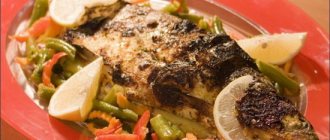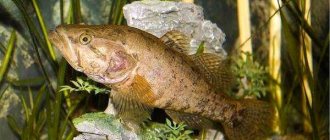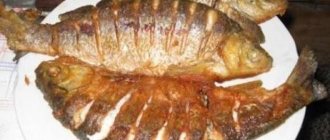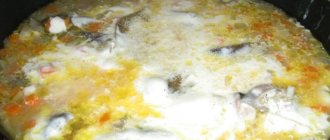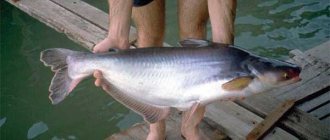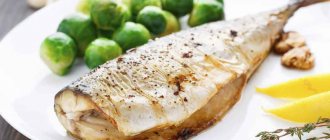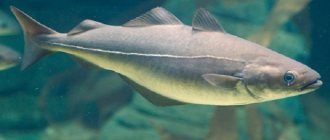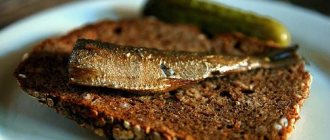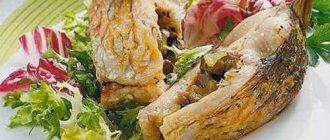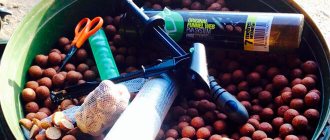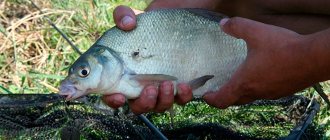Description
In appearance, the paddlefish can easily be identified as belonging to the sturgeon family. Fish has:
- Scorched torso.
- Elongated rostrum.
“Rostrum” in the language of biologists means a tactile organ that helps fish navigate in space. If you call it a locator, then this will be an accurate definition of its purpose. The fish has no scales, small bones (as, for example, in crucian carp) are completely absent. All these factors speak to the benefit of velinos, the cost of its processing is low, breeding for commercial purposes is profitable and advisable.
Necessary equipment, material
First you need to purchase breeding material. Each fry weighs about 25 mg. The recommended planting density is 2000-3000 specimens per 1 hectare.
It also happens: Catching and landing fish
Regular carp ponds do not require special equipment. The main thing is to ensure complete drainage and a system of independent water supply and collection. It is also necessary to ensure constant growth of phyto- and zooplankton.
Captured paddlefish are examined, weight assessed and measured. Catching this fish is not difficult.
Habitat
In Nature, paddlefish are found in the Mississippi River basin, its tributaries and lakes. If you look at the map, it will become clear that the habitat area extends over more than two thousand kilometers. The climate in different parts of this area varies quite significantly: in the north it is continental, in the south temperature norms and precipitation levels approach subtropical indicators. Back in the seventies of the last century, paddlefish were brought to the territory of Russia and Ukraine; this species of sturgeon was successfully bred by several large fish farms. Commercial breeding also continues in our time and brings good profits.
Food cravings
A characteristic feature of the paddlefish is its specific feeding habits (this is its main difference from the sturgeon). Preferred menu:
- Plankton.
- Daphnia.
- Rotifers.
- Various algae.
- Larvae.
Fish swim with their mouths half open, this helps them constantly filter the water, which is saturated with nutritious plankton. The bristles located on the gills are also actively used in this process.
The difference from most sturgeons is that the paddlefish is not a predator; it lives in bodies of water where the following are also found:
- carp;
- silver carp;
- bream
Steamed fish steak in a slow cooker
In order for steamed fish in a slow cooker to turn out delicious, you need to choose it correctly. A piece that is too fatty, such as catfish, will not work. Fish of medium fat content, for example, a piece of grass carp, is ideal. It is moderately greasy and without a specific smell.
Steamed grass carp steak
Ingredients
- A piece of medium-fat fish, such as grass carp
- A pinch of salt
- 2 sprigs of dill with seeds
- Black or lemon pepper to taste
Cooking method
- We wash the piece of grass carp steak and salt it to taste.
- Sprinkle with a little pepper (it’s better to use lemon, as it goes well with fish products).
- Place the washed branches with dill seeds into the steaming basket.
- Place the steak on top. We place the basket into the multicooker bowl, into which we do not forget to pour 1.5 cups of water.
- Cook on the “Steam” program for about 15-20 minutes. Cooking time depends on the thickness of the fish piece.
- Serve the steamed fish with fresh vegetables. You can offer it with mashed potatoes or porridge.
Breeding
Paddlefish are grown in Central and Southern Russia, and sometimes water bodies are equipped with coolers. Artificial breeding does not make it possible to use growth resources 100%. The fish grows up to seven kilograms if it is at least five years old. In this case, all feeding instructions must be followed.
Young paddlefish can weigh only one kilogram (minimum body weight from 150 grams). Growing paddlefish is not difficult, the care technology is simple, and the fish is unpretentious. The area of the reservoir is required from 70 hectares; it is desirable that it also be inhabited by:
- Silver carp.
- Carp.
The water must be saturated with oxygen, heated to a temperature of at least + 20 °C, the bottom is covered with vegetation and silt. The fish is heat-loving, so breeding in warm countries is economically feasible; it’s not for nothing that many Latin American companies are interested in cultivating this species.
Paddlefish farming is not practiced in the United States; it is caught on an industrial scale only in the Osage Rivers and Lake of the Ozarks.
How to grow paddlefish in a pond
The paddlefish is an amazing creature, because this species can live in almost any climate, from subtropical to harsh continental.
Growing paddlefish is only possible in reservoirs with a good bottom and the ability to supply and pump out water (Figure 16). In fact, ponds in which carp were previously raised are suitable for this species, but it should be borne in mind that in order to obtain enough meat, paddlefish must be kept for several years.
For feeding, they use natural food from reservoirs (zooplankton and phytoplankton). To ensure that paddlefish always have access to natural food supply, mineral fertilizers must be added to the pond, often in fractional portions
It is important to thoroughly dissolve the fertilizer in the water so that paddlefish do not eat its particles and become poisoned. Superphosphate, lime, potassium permanganate or very high-quality rotted manure after preliminary laboratory testing for chemical composition are suitable for fertilizing a reservoir.
Peculiarities
There are some features that must be taken into account when raising paddlefish.
Read Catching pike with a spinnerbait and making your own bait
Firstly, you cannot keep fry and adult fish in the same reservoir. If the pond becomes overpopulated, the adults will begin to eat the young ones.
Figure 16. Breeding paddlefish in a home pondHerbivorous fish are considered the best neighbors for paddlefish, with the exception of silver carp, which is very close to paddlefish in terms of food ration, therefore, mainly carp, black carp and channel catfish are introduced into ponds.
The profitability of paddlefish breeding is also explained by the fact that this fish is very easy to catch using a seine or any other simple fishing device.
Rules
In order for paddlefish breeding to be successful, it is necessary to provide the individuals with a good flow of oxygen, since paddlefish are more demanding when it comes to saturating the reservoir with air.
Larvae and fry are kept separately from adults, and from the age of one year they are bred together with other fish (silver carp, white and black carp).
Grown-up individuals, starting from the age of seven, are kept in separate reservoirs, and for the winter they are placed in separate ponds. They must be deep enough, at least one and a half meters, so that fish can move freely in the water column even after the surface of the reservoir freezes.
The larvae are fed with small aquatic insects and zooplankton, and it is advisable to feed it in a suspended state. Adult individuals are necessarily weighed during the capture process and only the largest individuals are selected, while the rest are left for caviar production.
Nutritional qualities
Paddlefish meat has a lot of micronutrients and minerals. Regular consumption of dishes prepared from meat and caviar promotes good vitality and immunity. Improved performance:
- Gastrointestinal tract.
- The cardiovascular system.
- General metabolism.
- As they strengthen, the walls of blood vessels become more elastic.
Fish contains a high concentration of the vital element omega-3 acid. This microelement prevents the development of cancer, it is especially useful for children and pregnant women. Paddlefish meat is not bright red, as, for example, in salmon, its tone is not pronounced and can vary.
Human interaction
It is of minor commercial importance in the United States. Meat and caviar are highly prized. In 1958, its total catch in the Osage River - Lake of the Ozarks area was 88.6 tons, in 1961 - 63.2 tons. In the USA, paddlefish are bred artificially. Since 1974, work has been carried out on the acclimatization of paddlefish in the southern reservoirs of the European part of the USSR. Typically, paddlefish are caught using large nets (up to 3 km long and 10 m high) from boats. In some places, special wire gear with sinkers and hooks and gill nets are used. The International Union for Conservation of Nature has assigned the species Conservation_status "Vulnerable".
Read Ear from the tail and head of pink salmon
Aquarium content
Recently, the paddlefish has become a popular aquarium fish. The aquariums contain young paddlefish 15 cm long. By the age of one year they reach 30 cm, and for development they require space many times greater than the capabilities of a home aquarium. For juvenile paddlefish (up to 1 year), an aquarium of 200 liters or more is suitable. Paddlefish are suitable for coarse soil, which this fish swimming in the water column cannot scoop up with its mouth. The water temperature should be +15…+27 °C. Filtration, aeration and weekly 1/5 water changes are required. It is desirable to create a circular flow. In a 1000-liter aquarium, paddlefish can live up to 10 years (in nature, these fish live up to 80 years).
In the USSR and Russia
It was first introduced into the USSR in 1974 and began to be cultivated in a number of fish farms in Ukraine. In Crimea, the paddlefish was delivered to the Krasnoperekopsk fish factory for the purpose of acclimatization and reproduction.
In the mid-1970s, the paddlefish was brought to Russia and is currently kept in fish farms, where it successfully matures and produces offspring. Released into the Krasnodar reservoir and Voronezh reservoir. A case of capture was noted in Lake Velikoy, Kostroma Region, and the Strugov Reservoir in the Oktyabrsky District of Primorye, as well as the Samara River in the city of Samara.
This is interesting: Pelengas fish - photo and description, equipment for fishing, do-it-yourself bait, what it bites on
Delicious dishes
To prepare one of the most delicious fish dishes, “Royal Paddlefish,” the following ingredients are required:
- Up to 3 kg of fish;
- Lemon – 1 pc.;
- Ground black pepper 2 teaspoons;
- Salt 2 teaspoons;
- Sunflower oil (refined) 120 ml;
- Dry protein wine 200 ml.
You can also add spices and herbs to taste. The fish is cleaned and thoroughly washed, then salted outside and inside. It should be left for 30-40 minutes, then the salt should be washed off with running water. Rub the fish carcass with the prepared spice mixtures, squeeze lemon juice onto the carcass, rub with vegetable oil and wine. The carcass is wrapped in foil and placed on a baking sheet. Baking takes place for 17 minutes over medium heat, before which the oven should already be preheated to 170 °C. After development, the dish cools down a little, and the foil is unrolled. Sprinkle with herbs, carefully cut the carcass into equal parts, sprinkle with lemon juice, serve, this dish is good to eat with dry white wine.
You can buy live paddlefish in Moscow and the Moscow region with delivery on our website
Fish steak on the grill
Any steak, including fish, was originally intended to be cooked over coals; it is the living warmth of the fire that gives the fish a unique taste. Therefore, fish steaks cooked on the grill have a special taste and aroma. You can use both white and red fish, as long as it is chilled and not frozen.
Grilled salmon steak
Ingredients
- 1 salmon steak for 1 serving
- 1 lemon
- Salt to taste
- Black pepper to taste
Cooking method
- Cooking coals. They should be hot, but without open flame. Place the open grate on the grill.
- On one side, salt and pepper the steak. Place the steaks on the grill, salted side down. Salt and pepper the second side.
- Close the grill and cook the fish. Each side takes 5-7 minutes.
- Place the finished steaks on plates and pour over lemon juice. Bon appetit.
See also: How to get rid of dandruff at home recipe

